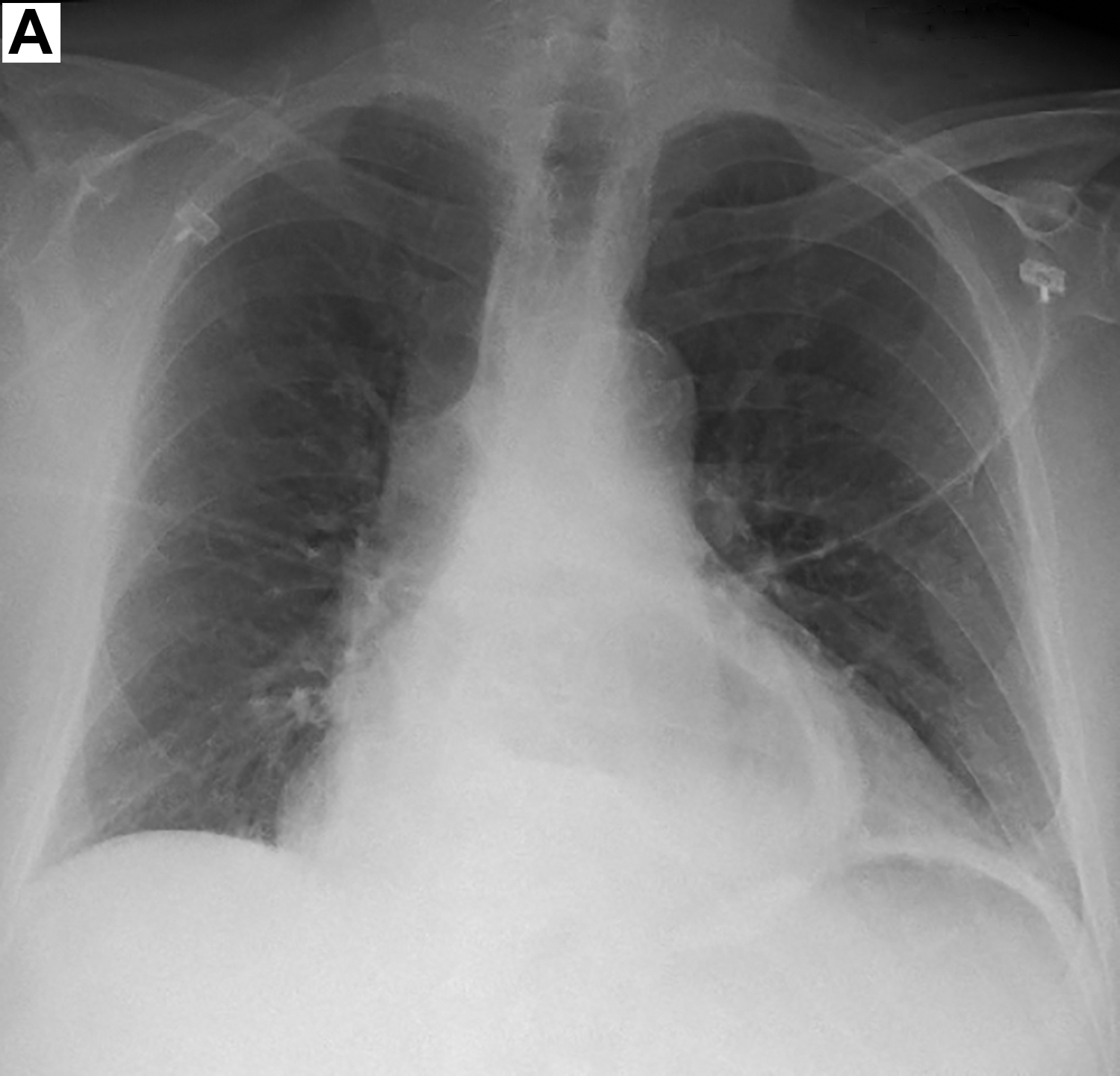Strangulated Paraesophageal Hiatal Hernia
-
Ryan Hoff
A 76-year-old man was admitted to the hospital with nonexertional epigastric pain radiating to the lower chest. His medical history included gastroesophageal reflux disease. Plain-film (single view) radiographic chest images demonstrated a large hiatal hernia (image A). A nothing-by-mouth diet was prescribed, but the patient continued to have significant epigastric discomfort. Nasogastric intubation resulted in drainage of 3 L of gastric secretions. Computed tomographic images without contrast demonstrated a large strangulated paraesophageal hernia (image B, arrow). The patient underwent robotic-assisted laparoscopic repair of the hernia with surgical mesh. His postoperative course was complicated by sepsis, which resolved after a short course of cefepime.


Paraesophageal hernias are less common and more severe than sliding hernias. Symptoms may include chest pain, abdominal pain, or respiratory distress. The rate of progression to symptoms is about 14% per year.1 Complications include obstruction, bleeding, strangulation, perforation, respiratory compromise, and gastric volvulus.1 All symptomatic and any complicated paraesophageal hiatal hernias should be surgically repaired, usually laparoscopically.1 Surgical repair improves quality of life and mortality rates,2 and recurrences are rare.3
References
1. Kohn GP , PriceRR, DeMeesterSR, et al. Guidelines for the management of hiatal hernia. Surg Endosc. 2013;27(12):4409-4428. doi:10.1007/s00464-013-3173-3Suche in Google Scholar PubMed
2. Le Page PA , FurtadoR, HaywardM, et al. Durability of giant hiatus hernia repair in 455 patients over 20 years. Ann R Coll Surg Engl. 2015;97(3):188-193. doi:10.1308/003588414X14055925060839Suche in Google Scholar PubMed PubMed Central
3. White BC , JeansonneLO, MorgenthalCB, et al. Do recurrences after paraesophageal hernia repair matter? ten-year follow-up after laparoscopic repair. Surg Endosc. 2008;22(4):1107-1111. doi:10.1007/s00464-007-9649-2Suche in Google Scholar PubMed
© 2018 American Osteopathic Association
This work is licensed under the Creative Commons Attribution-NonCommercial-NoDerivatives 4.0 International License.
Artikel in diesem Heft
- CASE REPORT
- Nontraumatic First Rib Fracture and Empyema Presenting as Shoulder Pain
- OMT MINUTE
- OMT for Patients With Sacral Somatic Dysfunction
- EDITORIAL
- A Focus on Research at the First School of Osteopathic Medicine
- The Safety of Osteopathic Manipulative Treatment (OMT)
- STILL RELEVANT?
- Addressing the Opioid Crisis Through the Teachings of A.T. Still
- ORIGINAL CONTRIBUTION
- Characterizing Adverse Events Reported Immediately After Osteopathic Manipulative Treatment
- Influence of Transverse Process Landmark Localization on Palpation Accuracy of Lumbar Spine Models
- Ultrasonographic Evaluation of the Effect of Osteopathic Manipulative Treatment on Sacral Base Asymmetry
- Tool for Predicting Medical Student Burnout From Sustained Stress Levels: Factor Analysis of the Medical Education Hassles Scale-R
- REVIEW
- Role of Magnesium in Vitamin D Activation and Function
- JAOA/AACOM MEDICAL EDUCATION
- Increasing Self-Awareness of Medical Students Through the Use of Ultrasonography
- Physician-Mentored Patient Rounds to Observe and Assess Entrustable Professional Activities 1 and 2 in Preclinical Medical Students
- CLINICAL IMAGES
- Strangulated Paraesophageal Hiatal Hernia
Artikel in diesem Heft
- CASE REPORT
- Nontraumatic First Rib Fracture and Empyema Presenting as Shoulder Pain
- OMT MINUTE
- OMT for Patients With Sacral Somatic Dysfunction
- EDITORIAL
- A Focus on Research at the First School of Osteopathic Medicine
- The Safety of Osteopathic Manipulative Treatment (OMT)
- STILL RELEVANT?
- Addressing the Opioid Crisis Through the Teachings of A.T. Still
- ORIGINAL CONTRIBUTION
- Characterizing Adverse Events Reported Immediately After Osteopathic Manipulative Treatment
- Influence of Transverse Process Landmark Localization on Palpation Accuracy of Lumbar Spine Models
- Ultrasonographic Evaluation of the Effect of Osteopathic Manipulative Treatment on Sacral Base Asymmetry
- Tool for Predicting Medical Student Burnout From Sustained Stress Levels: Factor Analysis of the Medical Education Hassles Scale-R
- REVIEW
- Role of Magnesium in Vitamin D Activation and Function
- JAOA/AACOM MEDICAL EDUCATION
- Increasing Self-Awareness of Medical Students Through the Use of Ultrasonography
- Physician-Mentored Patient Rounds to Observe and Assess Entrustable Professional Activities 1 and 2 in Preclinical Medical Students
- CLINICAL IMAGES
- Strangulated Paraesophageal Hiatal Hernia

